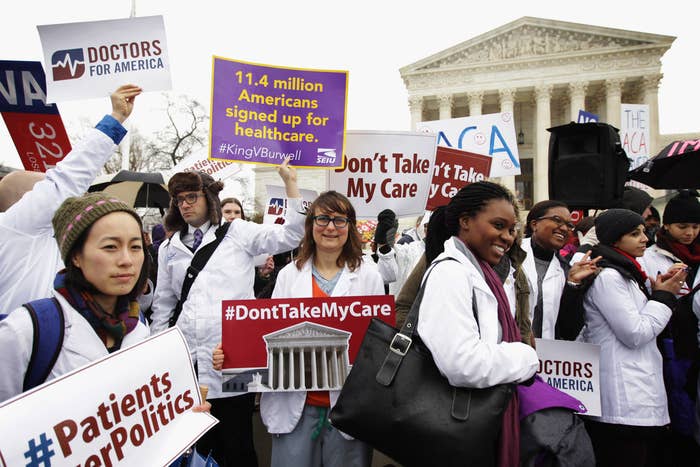
WASHINGTON — Although past arguments over Obamacare show nothing is final until a decision is rendered, a majority of the justices appeared reluctant to send Obamacare into the "death spiral" that the government warned would occur if the court ruled that the law does not permit the government to subsidize health insurance purchased under the federal exchanges.
Specifically, Justice Anthony Kennedy, a potential swing vote in the case, appeared skeptical about whether a ruling disallowing subsidies under the federal exchange would create unconstitutional coercion from the federal government on the states. With differing reasons, the four more liberal justices — more clearly — also appeared to back the government's interpretation of Obamacare.
Chief Justice John Roberts — the key vote upholding Obamacare in the 2012 constitutional challenge to the law — stayed mostly silent Wednesday, giving few clues as to his views on the challenge.
The coercion issue raises a "serious constitutional problem," Kennedy told Mike Carvin, the Jones Day lawyer representing the people who challenged the government's implementation of the law.
Carvin's argument, once considered a long shot, is that the language of the statute prevents the health care subsidies available under the act from being given to those people purchasing their health insurance through the federal exchange.
If subsidies aren't available to those getting their health insurance through the federal exchange, it would, effectively, kill Obamacare because a significant number of people would no longer be able to afford health insurance — a reality acknowledged by the Obama administration in recent days.
The law itself says subsidies are to be available to those who purchase health insurance on exchanges "established by the State." The challengers say that the "plain text" of the statute therefore prohibits subsidies to those who purchase their health insurance through the federal exchange — excluding millions of people from the subsidy, given that well over half the states did not set up state exchanges.
Justices Elena Kagan and Sonia Sotomayor, joined at points by Justices Stephen Breyer and Ruth Bader Ginsburg, appeared at points to find — or at least argue — that the challengers' arguments to be somewhat incomprehensible.
When Carvin argued that there was no legislative history to support the "death spiral" concern regarding the federal subsidy, Sotomayor shot back that it was "the entire point of the legislation."
Kagan described the "draconian choice" Carvin's argument would have states make, asking why the court should believe this is the most logical reading of the statute when "it took a year and a half" for this issue to be raised.
The federal government, represented by Solicitor General Donald Verrilli Jr., pointed to the entirety of the statute, and not just those four words, to argue that Obamacare provides for the subsidy to be available to any eligible taxpayer — the "only way" to interpret the act given its "structure and design."
Justice Antonin Scalia and Samuel Alito were incredulous.
When Verrilli argued that the statute must be read to allow subsidies for those on the federal exchange in order to make sense of the statute, Scalia shot back, "There are no statutes that make no sense?"
At the least, the federal government argues, the Treasury Department's interpretation of the statute to allow the subsidies for all exchanges is a "permissible" interpretation to which courts should defer — an argument that Scalia said was only available if the "established by the State" provision is reasonably read in any way other than meaning only state exchanges are eligible.
Even if multiple readings are possible, the challengers argue that the decision to extend subsidies to the federal exchange should not be given deference by the court.
A decision in the case is expected by late June.
